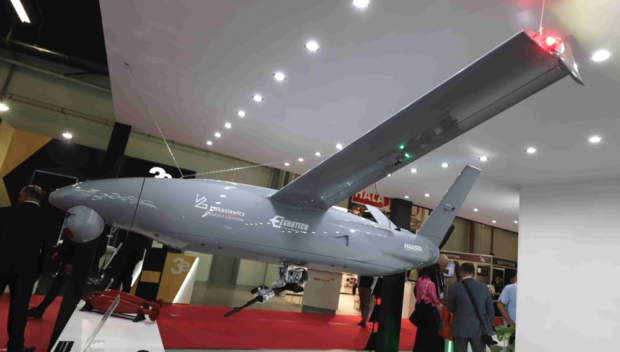The Polish government hasrolled out a new armed, unmanned aerial vehicle concept aimed at countering smaller drones, known as the HAASTA, to kick off the annual MSPO defense trade show.
In the announcement, the government stated the design draws on “insights gained from recent years of combat operations” — a not-so-veiled reference to the Ukraine conflict, which Poland has been studying intensely. Design of the system follow a new standard, STANAG 4703, which sets airworthiness requirements for fixed-wing light unmanned aircraft.
Designed through the Łukasiewicz Institute of Aviation in cooperation with Italian firm EuroTech, HAASTA has a wingspan of just under 13 feet, is 9.5 feet long, and can carry a payload up to 77 pounds inside its bay. A 20 HP ICE-electric hybrid engine powers the design, which claims speeds of 74 to 170 miles per hour, with and an altitude over four miles high.
The system is designed to be launched from an air launcher and lands on a skid or gliding parachute, rather than requiring traditional airport infrastructure. The operating radius on paper is 30 km with standard radio, 80 km in a mesh system, or 170 km (LoS link with directional antennas). If connected to a satellite, the range is limited to fuel — with a maximum endurance of 10 hours.
The drone’s main task will be hunting for low velocity flying Shahed-type drones (the kind used heavily by Russia in Ukraine), searching for combustion engine emissions, and after positive identification, destroying the enemy target with its underbelly mounted 5.45mm machine gun. In the future, it may be possible to arm the design with a 7.62mm or 12.7mm UKM with ammunition belt or alternatively with two 20kg free fall bombs in fuselage.
However, there could be other uses for the system. The designers claim the ability to penetrate air defenses, operate deep in enemy territory and perform ISR missions, as well as the potential to swarm in order to confuse anti-aircraft defenses. And the design was shown off in its “fighter” variation, Łukasiewicz sees potential civilian versions as well, which could be used for monitoring long distance linear infrastructure, cargo transport, or photogrammetry.
According to Institute of Aviation representatives, the aircraft has successfully passes a series of flight tests. While still in the concept demonstration phase, designers are hoping to attract customers for the future.
Source: Breaking Defense

